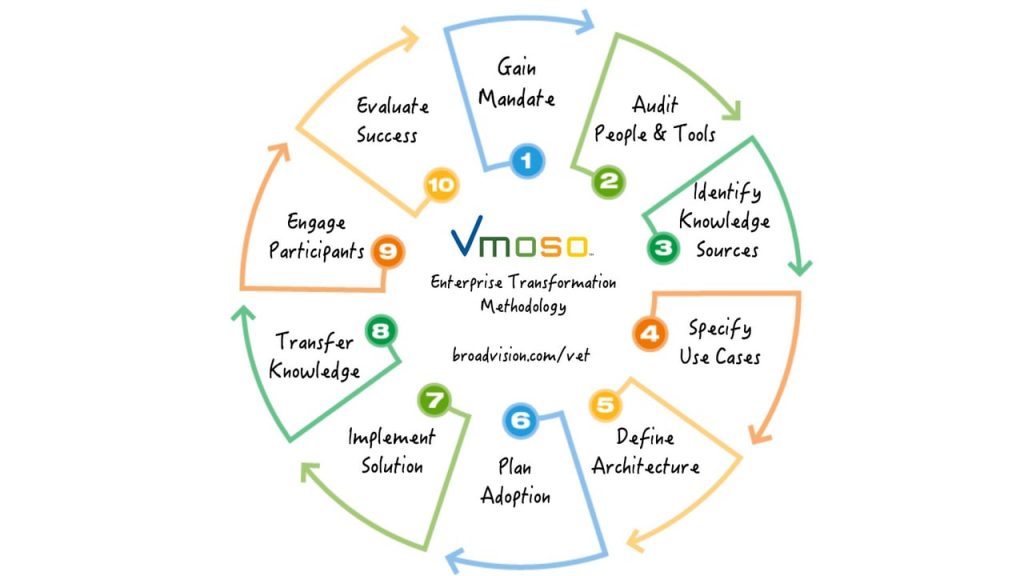As organizations embark on programmes of digital transformation, managing collective knowledge is becoming more important than ever. Knowledge is increasingly lost in employees’ email inboxes, or fragmented across a chaotic assortment of new communication tools brought in to address email’s failings.
At BroadVision, we understand that getting your corporate knowledge under control is more than just a technology implementation programme. The Vmoso Enterprise Transformation (or VET) methodology is a 10-step iterative process that refines working practices and establishes Vmoso at the heart of your enterprise communication and collaboration.
VET help organizations:
- Identify and integrate existing knowledge sources
- Capture new knowledge at source and index it for easy access
- Define collaborative processes to add accountability to business communication
- Devise and report upon meaningful metrics that link directly to business objectives
We know that the hardest part of any project to adopt new technology is getting started. Many employees remained wedded to working practices that discourage effective collaboration and impede the flow of information around the company. The VET methodology engages with all participants and stakeholders to drive behavioural change alongside Vmoso product implementation.
Let’s take a look at the ten steps in one cycle of the VET methodology.
- First of all, it’s essential to gain a mandate for the project from the executive sponsor. Experience shows that without clear objectives from senior management, and commitment to make the people involved in the project available, it will be very hard to make the rest of the project successful. So before we do anything else, we need to establish project charter, endorsed by company management.
- Next, we audit the communication and collaboration tools currently in use, and who’s using them. Digital transformation is a journey, and to define a realistic destination, we need to understand where we’re starting.
- Then, we identify where the vast amount of collective knowledge in the organisation is currently stored, and decide whether that should be migrated to Vmoso, or left in place and integrated to Vmoso.
- In step 4, we specify the use cases that are going to be implemented in this iteration of the methodology. The priority here is choosing those cases where we are most likely to see the biggest benefit, based on what we discovered in steps 2 and 3.
- Then we design the knowledge architecture – how we are going to organise the information that will be held in Vmoso or integrated to it. This includes the Vmoso spaces, user groups and access control restrictions. We also map the business workflows we’ve identified in previous steps into Vmoso-based collaborative processes.
- Next, we plan the schedule for the adoption phases of the project. This includes any technical integration and customization work required, the training schedule, and the metrics that are going to be used to evaluate success.
- The length of the solution implementation itself will vary based on the amount of integration and customization work, so may be anything between a few days and many weeks, depending on decisions made earlier in the project.
- Next, we transfer knowledge to the project steering committee and then all project participants. This includes not just Vmoso product training, but how the new working practices will be applied.
- Then, of course, we need some time for the system to be used in the way it has been designed. The length of this phase can be anything between a few weeks and several months, with regular steering committee meetings to monitor progress.
- Finally, we evaluate the results of the project against the success criteria defined earlier. Inevitably, some things will have worked well, some less so – this is essential input into the next iteration of the project, which starts again back at the “gain mandate” step.
VET is a continuous improvement programme. At BroadVision, we understand that behavioural changes take time and the end goal is only reached through a series of smaller steps. The results of one phase of the project feed directly into the definition of the next. Each iteration delivers invaluable data about which initiatives have worked, and which need to be reviewed. So the journey from noise and miscommunication to a streamlined “big knowledge” environment is taken gradually, not as one big leap.
BroadVision Global Services have been assisting leading enterprises around the world with their digital business initiatives for more than 20 years. Throughout the VET process, consultants from our Digital Transformation Group are here to help you. We’ll take part in your steering committee meetings, assist with project scoping and implementation, and training project participants.
The Vmoso Enterprise Transformation Methodology formulates and executes a clear, realistic, achievable plan for digital transformation of your communication, collaboration and engagement. It unlocks collective knowledge stored in fragmented systems across your organisation and introduces dynamic, collaborative processes to your business workflows.
